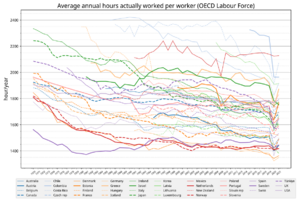Work–family conflict facts for kids

Have you ever felt like your schoolwork and family time are clashing? That's a bit like what adults feel with work–family conflict. It happens when someone has trouble balancing their job and their family life. This can make it hard to do well at both. When work and family demands don't fit together, it can cause stress. It might even lead to feeling tired all the time or having health problems. Understanding this conflict helps both people and companies.
Contents
What is Work–Family Conflict?
Work–family conflict was first looked at a long time ago, in the late 1800s. Back then, most people worked on farms at home. But then, factories started to appear. Work and earning money moved outside the home. This big change made people think differently about how work and family fit together.
Two main ideas help us understand work-family conflict: Boundary theory and Border theory.
- Boundary theory says that our lives are split into two main parts: work and family. In each part, we have different jobs and things we need to do. Since these parts are connected, you can't do both at the same time. People have to switch between being a worker and being a family member.
- Border theory builds on this idea. It looks at how work and family affect each other. This theory tries to find ways to handle conflicts and find a good balance. People might try to keep work and family totally separate. Or, they might try to mix them together, hoping to find a balance.
Different Kinds of Conflict
The clash between work and family can go both ways. We talk about work-to-family conflict and family-to-work conflict.
- Work-to-family conflict happens when things at work get in the way of family life. For example, if someone works very long or changing hours. Or if they have too much work and feel stressed. Maybe they travel a lot for their job. An unexpected meeting late in the day could stop a parent from picking up their child from school.
- Family-to-work conflict happens when family life gets in the way of work. This could be if someone has young children or needs to care for older family members. Family arguments can also cause this. For example, a parent might need to take a day off work to care for a sick child. Or they might miss work to see their child's school play. When family issues affect work, it can make employees less productive.
Within these two types, there are three smaller kinds of conflict:
- Time-based conflict means you don't have enough time for both work and family.
- Strain-based conflict means stress from one part of your life makes it hard to do well in the other.
- Behavior-based conflict means the way you act at work doesn't fit with how you need to act at home.
Even though work affecting family and family affecting work are connected, people often focus more on work affecting family. This is partly because of the idea of the "ideal worker." This idea suggests that employers expect workers to put their job first, as if they have no family duties at home. Many companies still think that employees with families have someone else taking care of everything at home. This idea creates work-family conflict for many people.
When Work Takes Over: Workaholism
Workaholism is when someone spends a huge amount of time on their job. It often leads to work-to-family conflict. A person who is a workaholic puts their job before everything else. This can stop them from having close relationships with family and friends.
Workaholics often spend so much time on work that they miss out on important family events, social activities, and hobbies. This can lead to problems in marriages and friendships. They might even feel lonely.
Luckily, many employers are now realizing how much stress work can put on people. Companies are starting to see their employees as people with lives outside of work. They are putting in place policies that help people balance work and family. This helps reduce stress for everyone.
How Companies Can Help
Companies can do a lot to help reduce work-family conflict. Think of it like a professional athlete. Athletes need to work hard, but they also need time to rest and recover. If they don't rest, they get tired and can even get hurt. It's the same for people at work. If they are always stressed without a break, it can cause long-term problems.
Companies can create a workplace that values breaks and recovery. For example, they might encourage short walk breaks during the day. Or they might offer gym memberships. This can help employees think better, have more energy, and focus more. When companies care about their employees' mental and physical health, everyone wins. Employees are happier and perform better. This also helps companies attract and keep good workers.
Here are some ways companies can help:
- Family-friendly policies: These include things like time off for new parents (maternity or paternity leave). They also include sick leave and health insurance.
- Child care options: Some companies have child care centers right at the workplace. Others might give lists of nearby centers or help pay for child care.
- Using technology: With new technology, people can stay connected with family even when they are away for work. Companies can also offer remote work (working from home) or flextime (flexible work hours). This gives employees more control over their schedules.
The Role of Gender
Gender can play a big part in work-family conflict. This is because a person's gender can affect their roles at home and at work. The idea of the "ideal worker" often causes problems for women. Many companies see the "ideal worker" as someone who puts their job above everything else. These workers are seen as more dedicated. But people who have to split their time between family and work are sometimes seen as less committed.
Managers often expect women to be "ideal workers." But women often have big responsibilities at home too. This means they can feel more work-life conflict. For example, in Germany in 2018, mothers spent almost three times more time on child care than fathers did. Studies show that women often face more work-family conflict than men. This is partly because women often have less control over their work and schedules.
Sometimes, managers might think that women who are balancing work and family are less committed to their jobs. This can unfairly stop women from getting promoted. Men, on the other hand, might be seen as more dedicated because they seem to have less work-family conflict.
The motherhood penalty is a term for how working mothers can face disadvantages at work. This includes lower pay, being seen as less capable, and fewer benefits compared to women who don't have children. Working mothers might get paid less for each child they have. This can make the pay gap between mothers and non-mothers even bigger than the gap between men and women. Mothers might also get lower ratings in job reviews. They might be seen as less committed or dependable. This can lead to unfair treatment in pay, hiring, and daily work life.
The way companies have shaped the "ideal worker" doesn't always fit with family life. Long hours and needing to be totally devoted to a job make it hard for working mothers to get ahead while also caring for their home and family.
See also
- Chronic stress
- Critique of work
- Dassler brothers feud
- Emotional intelligence
- Job performance
- Job stress
- Occupational burnout
- Organizational commitment
- Organizational hierarchy
- Work-life interface
- Workaholic


